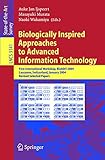Biologically Inspired Approaches to Advanced Information Technology [electronic resource] : First International Workshop, BioADIT 2004, Lausanne, Switzerland, January 29-30, 2004, Revised Selected Papers / edited by Auke Jan Ijspeert, Masayuki Murata, Naoki Wakamiya.
Material type: TextSeries: Lecture Notes in Computer Science ; 3141Publisher: Berlin, Heidelberg : Springer Berlin Heidelberg, 2004Description: XIV, 516 p. online resourceContent type: text Media type: computer Carrier type: online resourceISBN: 9783540278351Subject(s): Computer science | Computer Communication Networks | Computer software | Information systems | Artificial intelligence | Computer vision | Computer Science | Computation by Abstract Devices | Computer Communication Networks | Artificial Intelligence (incl. Robotics) | Algorithm Analysis and Problem Complexity | Image Processing and Computer Vision | Information Systems Applications (incl.Internet)Additional physical formats: Printed edition:: No titleDDC classification: 004.0151 LOC classification: QA75.5-76.95Online resources: Click here to access online
TextSeries: Lecture Notes in Computer Science ; 3141Publisher: Berlin, Heidelberg : Springer Berlin Heidelberg, 2004Description: XIV, 516 p. online resourceContent type: text Media type: computer Carrier type: online resourceISBN: 9783540278351Subject(s): Computer science | Computer Communication Networks | Computer software | Information systems | Artificial intelligence | Computer vision | Computer Science | Computation by Abstract Devices | Computer Communication Networks | Artificial Intelligence (incl. Robotics) | Algorithm Analysis and Problem Complexity | Image Processing and Computer Vision | Information Systems Applications (incl.Internet)Additional physical formats: Printed edition:: No titleDDC classification: 004.0151 LOC classification: QA75.5-76.95Online resources: Click here to access online  E-BOOKS
E-BOOKS
| Current library | Home library | Call number | Materials specified | URL | Status | Date due | Barcode |
|---|---|---|---|---|---|---|---|
| IMSc Library | IMSc Library | Link to resource | Available | EBK3280 |
Biosystems for IT Evolution -- Object-Oriented Specification of Complex Bio-computing Processes: A Case Study of a Network of Proteolytic Enzymes -- Analysis of Responses of Complex Bionetworks to Changes in Environmental Conditions -- Experimental Molecular Evolution Showing Flexibility of Fitness Leading to Coexistence and Diversification in Biological System -- Echo State Networks and Self-Prediction -- Learning Bayesian Networks by Lamarckian Genetic Algorithm and Its Application to Yeast Cell-Cycle Gene Network Reconstruction from Time-Series Microarray Data -- Towards Cortex Sized Attractor ANN -- Bio-inspired Software Systems -- Biologically Inspired Reinforcement Learning: Reward-Based Decomposition for Multi-goal Environments -- Dynamic Self-Assembly and Computation: From Biological to Information Systems -- Implementation and Evaluation of a System to Support Human Relationship Formation in Networked Virtual Space -- Biologically Plausible Speech Recognition with LSTM Neural Nets -- Spatial Tangible User Interfaces for Cognitive Assessment and Training -- Biologically Inspired Computer Virus Detection System -- Explaining Low-Level Brightness-Contrast Illusions Using Disinhibition -- Autonomous Acquisition of the Meaning of Sensory States Through Sensory-Invariance Driven Action -- Hardware Systems -- Characterizing the Firing Properties of an Adaptive Analog VLSI Neuron -- Embryonic Machines That Divide and Differentiate -- Artificial Cellular Division by Self-Inspection -- A Hardware Implementation of a Network of Functional Spiking Neurons with Hebbian Learning -- Robotics -- A Study on Designing Robot Controllers by Using Reinforcement Learning with Evolutionary State Recruitment Strategy -- Movement Generation and Control with Generic Neural Microcircuits -- Efficiency and Task Allocation in Prey Retrieval -- Anatomy and Physiology of an Artificial Vision Matrix -- Bio-inspired Distributed/Parallel Processing -- An Adaptive Mechanism for Epidemic Communication -- The Blob Division -- Distributed Central Pattern Generator Model for Robotics Application Based on Phase Sensitivity Analysis -- Ant-Based Approach to Mobile Agent Traversal -- Bio-inspired Networking -- An Ant Inspired Technique for Storage Area Network Design -- Media Streaming on P2P Networks with Bio-inspired Cache Replacement Algorithm -- An Artificial Immune System Approach to Misbehavior Detection in Mobile Ad Hoc Networks -- Scalable and Robust Scheme for Data Gathering in Sensor Networks -- Image Processing -- Biologically Inspired Image Compression in Biomedical High-Throughput Screening -- Naïve Algorithms for Keyphrase Extraction and Text Summarization from a Single Document Inspired by the Protein Biosynthesis Process -- Biologically Motivated Trainable Selective Attention Model Using Adaptive Resonance Theory Network -- Other Topics -- Searching for a Practical Evidence of the No Free Lunch Theorems -- How Collective Intelligence Emerge in Complex Environment? -- The Genealogy of Biomimetics: Half a Century’s Quest for Dynamic IT.
The evolution of the Internet has led us to the new era of the information infrastructure. As the information systems operating on the Internet are getting larger and more complicated, it is clear that the traditional approaches based on centralized mechanisms are no longer meaningful. One typical example can be found in the recent growing interest in a P2P (peer-to-peer) computing paradigm. It is quite different from the Web-based client-server systems, which adopt essentially centralized management mechanisms. The P2P computing environment has the potential to overcome bottlenecks in Web computing paradigm, but it introduces another difficulty, a scalability problem in terms of information found, if we use a brute-force flooding mechanism. As such, conventional information systems have been designed in a centralized fashion. As the Internet is deployed on a world scale, however, the information systems have been growing, and it becomes more and more difficult to ensure fau- free operation. This has long been a fundamental research topic in the field. A complex information system is becoming more than we can manage. For these reasons, there has recently been a significant increase in interest in biologically inspired approaches to designing future information systems that can be managed efficiently and correctly.


There are no comments on this title.